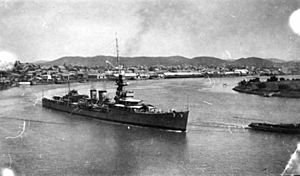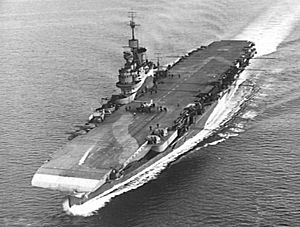Charles Lambe facts for kids
Quick facts for kids
Sir Charles Lambe
|
|
|---|---|

Admiral of the Fleet Sir Charles Lambe
|
|
| Born | 20 December 1900 Stalbridge, Dorset |
| Died | 29 August 1960 (aged 59) Newport-on-Tay, Fife |
| Allegiance | United Kingdom |
| Service/ |
Royal Navy |
| Years of service | 1917–1960 |
| Rank | Admiral of the Fleet |
| Commands held | First Sea Lord (1959–60) Mediterranean Fleet (1957–59) Far East Fleet (1953–54) Flag Officer, Air (Home) (1951–53) 3rd Aircraft Carrier Squadron (1949–51) Flag Officer, Flying Training (1947–48) HMS Illustrious (1944–45) HMS Dunedin (1939–40) |
| Battles/wars | First World War Second World War |
| Awards | Knight Grand Cross of the Order of the Bath Commander of the Royal Victorian Order Mentioned in Despatches (3) Legion of Merit (United States) Order of the Dannebrog (Denmark) |
Sir Charles Edward Lambe (1900–1960) was a very important officer in the Royal Navy. He became an Admiral of the Fleet, which is the highest rank in the British Navy. Sir Charles Lambe fought in both the First World War and the Second World War. During World War II, he commanded a cruiser ship and later an aircraft carrier. He also helped plan naval operations. He was even the head of the Royal Navy, known as the First Sea Lord, from 1959 until 1960. Sadly, he had to retire early because of a heart condition and passed away a few months later.
Contents
Charles Lambe was born on December 20, 1900, in Stalbridge, Dorset, England. His parents were Henry Edward Lambe and Lilian Hope Lambe. He went to the Royal Naval College, Osborne, a special school for future naval officers.
In 1914, at a young age, he joined the Royal Navy as a cadet. This was the start of his long and distinguished career.
First World War Service
On August 15, 1917, Charles Lambe became a midshipman and was assigned to the battleship HMS Emperor of India. He stayed on this ship until the end of the First World War.
After the war, in June 1919, he moved to another battleship, HMS King George V. He continued to rise through the ranks, becoming a sub-lieutenant in 1921 and a lieutenant in 1922.
Throughout the 1920s and 1930s, Lambe gained more experience. He served on several ships, including the cruiser HMS Raleigh and the battleship HMS Benbow in the Mediterranean Fleet. He also attended special training schools, like the torpedo school, HMS Vernon.
After his training, he became a torpedo officer on the destroyer HMS Stuart. He was promoted to lieutenant commander in 1930 and attended the Royal Naval Staff College in 1931. He then served on the cruiser HMS Hawkins.
In 1933, he became a commander and worked with destroyer fleets in the Mediterranean. He even served as an equerry (a personal attendant) to King George VI starting in 1936. By 1937, he was promoted to captain.
World War II and Beyond
Commanding Ships in Wartime
In January 1939, just before the Second World War began, Captain Lambe took command of the cruiser HMS Dunedin. He led this ship as part of the Northern Patrol, which helped protect shipping routes.
From October 1940, he worked in the Plans Department at the Admiralty, helping to organize naval strategies. He became the Director of Naval Plans in March 1942.
Leading an Aircraft Carrier
In May 1944, Captain Lambe was given command of the aircraft carrier HMS Illustrious. This ship was part of the British Pacific Fleet, fighting in the Pacific Ocean.
In April 1945, his ship survived a dangerous kamikazi attack. For his brave service during the war, he was mentioned in official reports three times and received the American Legion of Merit award.
Post-War Leadership Roles
After the war, Lambe continued to serve in important roles. In 1945, he became the Assistant Chief of the Naval Staff (Air), focusing on naval aviation. He was also a Naval Aide-de-Camp to the King in 1947.
He was promoted to rear admiral in 1947. He then became the Flag Officer, Flying Training, overseeing naval flight training. In 1949, he commanded the 3rd Aircraft Carrier Squadron.
An interesting fact: in 1950, he invited the composer Lennox Berkeley to join a naval cruise. Lambe, who was a skilled pianist, even had two grand pianos placed in Berkeley's cabin so they could play music together.
Rising to Admiral
Lambe continued to advance, becoming a vice admiral in 1950. He took charge of naval air operations at Lee-on-Solent in 1951. He also participated in the funeral of King George VI in 1952.
In 1953, he became the Commander-in-Chief, Far East Station, leading naval forces in that region. He was promoted to full admiral in 1954.
He then served as Second Sea Lord and Chief of Naval Personnel in 1955, responsible for naval staff. In 1957, he became the Commander-in-Chief, Mediterranean Fleet and a NATO commander.
First Sea Lord and Retirement
In May 1959, Admiral Lambe reached the highest point of his career, becoming the First Sea Lord and Chief of the Naval Staff. This meant he was the professional head of the entire Royal Navy.
However, just six months into this role, he suffered a serious heart attack. Because of his health, he had to retire early on May 10, 1960. On his retirement, he was given the highest rank of Admiral of the Fleet.
Sadly, Sir Charles Lambe passed away a few months later, on August 29, 1960, at his home in Newport-on-Tay in Fife.
Family Life
In 1940, Sir Charles Lambe married Lesbia Rachel Mylius. They had one son and one daughter together.



